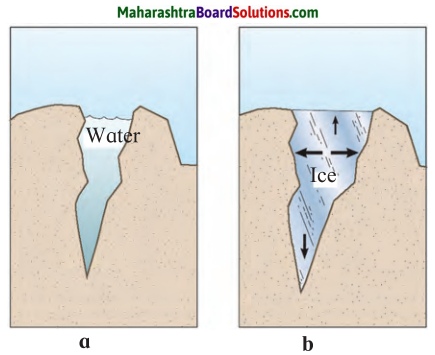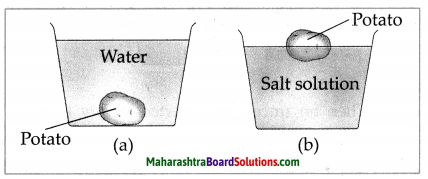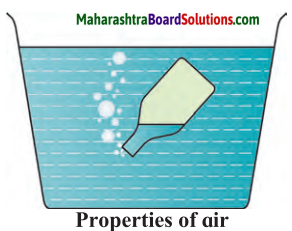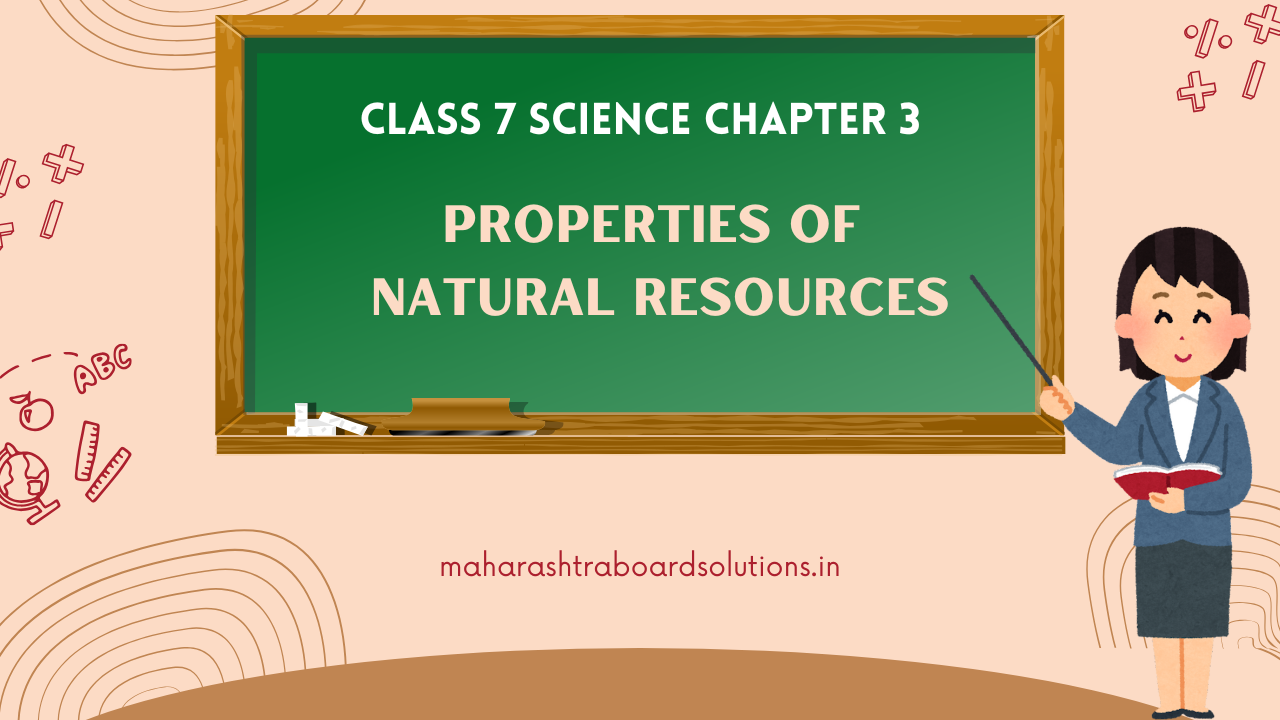Balbharti Maharashtra State Board Class 7 Science Solutions Chapter 3 Properties of Natural Resources Notes, Textbook Exercise Important Questions and Answers.
Std 7 Science Chapter 3 Properties of Natural Resources Question Answer Maharashtra Board
Class 7 Science Chapter 3 Properties of Natural Resources Question Answer Maharashtra Board
Fill in the blanks with the appropriate term.
Question 1.
The capacity of air to hold moisture depends upon the …………… of the air.
Answer:
temperature
Question 2.
Water does not have a …………… but has definite ………… and ………. .
Answer:
shape, volume, mass
![]()
Question 3.
While freezing, the ………….. of water is lowered.
Answer:
density
Question 4.
…………….. soil has pH 7.
Answer:
neutral
2. Why is the said that –
Question a.
Air is a homogeneous mixture of various gases.
Answer:
- Air is made of oxygen, nitrogen, carbondioxide, water vapour and dust particles.
- All these are in different proportions. Therefore air is a mixture.
![]()
Question b.
Water is a universal solvent.
Answer:
- Water dissolves more substances than any other liquid. It dissolves solids, other liquids and even gases in it. Therefore, it is called as Universal solvent.
- Water is used as a solvent in factories, laboratories, foodstuffs and in various types of biological processes occurring in the body such as digestion, excretion, etc.
Question c.
There is no alternative to water for cleaning purposes.
Answer:
Water is a universal solvent. It dissolves more substances than any other liquid so there is no alternative to water for cleaning purposes.
3. What will happen if……
Question a.
The amount of water vapour in the air increases.
Answer:
We feel the dampness or the humidity.
![]()
Question b.
Only one crop is grown repeatedly in the soil.
Answer:
The fertility of the soil decreases.
4. With whom should I pair up?
Question a.
| Column ‘A’ | Column ‘B’ |
| 1. Air | a. Excretion |
| 2. Water | b. Scattering of light |
| 3. Soil | c. Plasticity |
Answer:
| Column ‘A’ | Column ‘B’ |
| 1. Air | b. Scattering of light |
| 2. Water | a. Excretion |
| 3. Soil | c. Plasticity |
![]()
5. State whether the following statements are true or false.
Question a.
Sandy soil has low capacity for holding water.
Answer:
True
Question b.
Sea water is a bad conductor of electricity.
Answer:
False. Sea water is a good conductor of electricity
Question c.
The substance in which a solute dissolves is called a solvent.
Answer:
True
![]()
Question d.
The pressure exerted by air is called atmospheric pressure.
Answer:
True
6. Explain the picture in your own words.
Question a.
Explain the picture in your own words.

Answer:
- Diagram (a): Water is filled in the crack.
- Diagram (b): Water in the crack turns to ice due to decrease in temperature. When it turns to ice the volume increases and it expands. Due to expansion, the size of crack widens more than in diagram (a).
![]()
7. Write answers to the following questions in your own words.
Question a.
How is light scattered by the air?
Answer:
Air is a mixture of very fine particles of some gases, dust, smoke and moisture. When rays of light fall on these minute particles, the particles spread the light in all the directions. This natural phenomenon is called scattering of light.
Question b
Explain the various properties of water.
Answer:
Various properties of water are as follows:
- It is a fluid substance because it can flow.
- It does not have its own shape, it takes the shape of a container in which it is kept.
- It has a definite volume.
- It is a transparent liquid and it has no colour.
- It is tasteless and odourless.
- It is a universal solvent.
Question c.
Why is the density of seawater is more than that of rainwater?
Answer:
Seawater has many minerals dissolved in it as compared to rainwater. So due to more dissolved salts, density of seawater is more than that of rainwater.
![]()
Question d.
What is the importance of good soil structure?
Answer:
The fertility of soil depends upon soil structure. So importance of good soil structure is as follows: (a) Roots get sufficient supply of oxygen, (b) Water drainage is good therefore the roots of plants grow well.
Question e.
What are the various uses of soil?
Answer:
The uses of soil are as follows:
Plant conservation: To help plants grow. Water conservation: Soil holds water. As a result, by means of bunds and lakes, we can get water for use throughout the year.
Plasticity: (a) Soil can be given any required shape. This property of soil is called plasticity, (b) Because of its plasticity, we can use it to make articles of a variety of shapes, (c) These articles can be baked to make them hard, (d) Water storage earthen pots, earthen lamps, idols, bricks etc. are articles made from soil.
![]()
Question f.
What is the need and importance of soil testing from the point of view of farmers?
Answer:
- The properties of the various ingredients of soil can be determined by soil testing.
- During soil testing, the soil is examined for colour, texture and the proportion of organic matter in it.
- Soil is tested to find out if there is a deficiency of any ingredients and to decide what measures should be taken to remove the deficiency. These information would enable the farmers to maintain the fertility of the soil.
Question g.
What is the importance of air in transmission of sound?
Answer:
- Air is useful as a medium for the transmission of sound. Density of the air changes with temperature.
- If the density of air increases, we can hear the sound more loud and clear.
Question h.
Why should a glass bottle completely filled with water never be kept in a freezer?
Answer:
- Due to anomalous behaviour of water, when you cool water below 4°C, the volume of the water increases.
- Therefore when the glass bottle completely filled with water is kept in a freezer, water expands on cooling and its volume increases so glass bottle breaks.
- To avoid this, completely filled bottle is never kept in a freezer.
![]()
Project:
Question a.
Visit a soil testing laboratory. Learn the process of soil testing and share it with others.
Class 7 Science Chapter 3 Properties of Natural Resources Important Questions and Answers
Fill in the blanks with the appropriate term.
Question 1.
Air is a …………… of gases.
Answer:
mixture
Question 2.
Atmospheric pressure is the …………… in all the directions.
Answer:
same
Question 3.
…………… is used to measure atmospheric pressure.
Answer:
Barometer
![]()
Question 4.
As we go higher the sea level and the atmospheric pressure …………… .
Answer:
decreases
Question 5.
Pressure of air …………… when its velocity …………… .
Answer:
increases, decreases
Question 6.
…………… an effect of the difference in air pressure.
Answer:
Wind
Question 7.
The level of …………… in the air is determined by its capacity to hold water vapour.
Answer:
humidity
Question 8.
When the temperature of air is low, its capacity to hold the vapour is …………… .
Answer:
less
![]()
Question 9.
Air is useful as a …………… for the transmission of sound.
Answer:
medium
Question 10.
Water is a …………… substance.
Answer:
fluid
Question 11.
Ice is …………… than water.
Answer:
lighter
Question 12.
Density of ice is …………… than that of water.
Answer:
less
Question 13.
The space occupied by a substance is its …………… .
Answer:
volume
![]()
Question 14.
The storage of matter in a substance is its …………… .
Answer:
mass
Question 15.
The density of water is maximum at …………… °C.
Answer:
4°C
Question 16.
The substance in which the solute dissolves is called …………… .
Answer:
solvent
Question 17.
The particles of sandy soil are made of the mineral called …………… .
Answer:
silicon dioxide (quartz)
Question 18.
…………… soil has a highest water holding capacity.
Answer:
clay
![]()
Question 19.
…………… soil is red in colour.
Answer:
Terracotta
Question 20.
…………… soil is used in cosmetics.
Answer:
Multani
Question 21.
…………… is celebrated as World Soil Day.
Answer:
5th December
Question 22.
The excess of water vapour during the night or dawn is transformed into ………….. .
Answer:
dew
![]()
Question 23.
Under ordinary conditions atmospheric pressure at sea level is …………… Newtons per square mater.
Answer:
101400
Question 24.
Swedish Scientist …………… put forth the important principle that the pressure of air decreases when its velocity increases.
Answer:
Daniel Bernoulli
Question 25.
When rays of light fall on fine particles of air, the particles spread light in all the directions, this is called …………… of light.
Answer:
Scattering
Question 26.
…………… soil is easy to plough but less fertile.
Answer:
Sandy
Say whether true or false, correct and rewrite the false statements.
Question 1.
Terracotta soil is white in colour.
Answer:
False. Terracotta soil is red in colour
Question 2.
The fertility of soil depends upon soil structure.
Answer:
True
![]()
Question 3.
Multani soil is used to make statues and idols.
Answer:
False. Shadu soil is used to make statues and idols
Question 4.
Clay soil has the maximum proportion of small particles.
Answer:
True
Question 5.
Silt soil is not as ploughable as sandy soil.
Answer:
True
Question 6.
The colour of soil near land surface is darker than the colour of the lower layers.
Answer:
True
Question 7.
Kerosene is a universal solvent.
Answer:
False. Water is an universal solvent
Question 8.
The density of substance is the inter-relation between the volume and mass of a substance.
Answer:
True
Question 9.
Water is lighter than ice.
Answer:
False. Ice is lighter than water
![]()
Question 10.
Rotation of crops decreases the fertility of the soil.
Answer:
False. Rotation of crop increases the fertility of the soil.
Match the columns:
Question 1.
| Column ‘A’ | Column ‘B’ |
| 1. Concept of pH | a. pH higher than 7.5 |
| 2. Acidic Soil | b. pH 6.5 – 7.5 |
| 3. Neutral Soil | c. pH less than 6.5 |
| 4. Alkaline Soil | d. Sorensen |
Answer:
| Column ‘A’ | Column ‘B’ |
| 1. Concept of pH | d. Sorensen |
| 2. Acidic Soil | c. pH less than 6.5 |
| 3. Neutral Soil | b. pH 6.5 – 7.5 |
| 4. Alkaline Soil | a. pH higher than 7.5 |
Write short answers.
Question 1.
What is atmospheric pressure?
Answer:
The molecules of the gases in the air are in constant motion. When these molecules strike a body, they create pressure on that body. This pressure of air is called atmospheric pressure.
![]()
Question 2.
What is Bernoulli’s principle?
Answer:
Bernoulli’s principle is that the pressure of air ‘ decreases when its velocity increases while the pressure of air increases when its velocity decreases.
Give scientific reasons.
Question 1.
When the piston of a syringe is released, it is immediately pushed in.
Answer:
- On pulling the piston of a syringe with the inlet hole of the syringe closed, more space becomes available to the air in the syringe, and it becomes rarified.
- As a result, the pressure of the air in the syringe is lowered.
- Comparatively the pressure of the outside air is very high. So when the pulled out piston is A released, it is immediately pushed in.
Question 2.
Water droplets are seen on the outer surface of a glass having ice cubes in it.
Answer:
- Due to the ice cubes in the glass, the air surrounding the glass cools down.
- As the water vapour in this air cools down, it condenses and gets transformed into water.
- It is this water that collects on the outer surface of the glass.
Question 3.
Early morning dew drops are found on the grass.
Answer:
- During the dawn (early morning) when the temperature of air is low, its capacity to hold the vapour is less.
- At such times, the excess vapour is transformed into water droplets and we call them as dew drops.
![]()
Question 4.
During the afternoon we feel that the air is dry.
Answer:
- In the afternoon, when the temperature of the air is high, the capacity of the air to hold the moisture also increases.
- Then, compared to its full capacity to hold water the proportion of moisture in the air is less and we feel that the air is dry.
Question 5.
Earth’s surface remains warm and suitable for the living world on the earth.
Answer:
- The earth receives energy from the sun. This energy is reflected by the earth in the form of heat.
- The constituents of air surrounding the earth, such as water vapour, carbon dioxide, absorb a part of this heat and give it to the other constituents of air.
- So the Earth’s surface remains warm and suitable for the living world on the earth.
Question 6.
We can hear the whistle of a distant train clearly early in the morning in winter.
Answer:
- The density of air changes due to change in its temperature.
- In winter, temperature is low so the density of the air is more. So we can hear the whistle of a distant train clearly early in the morning in winter.
Question 7.
Ice floats on water.
Answer:
- When water freezes means it transforms into the soild state therefore its volume increases.
- When volume increases its density decreases
- Therefore, density of ice is less than the water, so ice floats on water.
![]()
Question 8.
In cold countries aquatic animals remain alive even after the rivers or lakes freeze in water.
Answer:
1. Due to anomalous behaviour of water, in cold countries when water gets cool and turn to ice, its volume increases, so its density decreases
2. Due to less density ice floats on water.
3. (a) Ice is a bad conductor of heat and electricity, (b) It doesn’t allow outside heat to go from the ice to water so water temperature below the ice doesn’t change, (c) It remains as water so aquatic animals remain alive even after the rivers or lakes freeze in winter.
Question 9.
It is easier to swim in the sea than in a well or a lake.
Answer:
- Sea water is saline. It contains salt whereas it is not so in well or a lake water.
- Due to salts dissolved in sea water, density of sea water is more, so the swijnmer will not sink.
- Hence, it is easier to swim in the sea than in a well or a lake.
Question 10.
Sandy soil is less fertile.
Answer:
- Sandy soil is made up of large particles and these particles of sandy soil are made of the mineral called silicon dioxide.
- These particles do not dissolve in water therefore soil has very little capacity to supply nutrients, so sandy soil is less fertile.
![]()
Question 11.
China clay is used for making crockery.
Answer:
China clay is used for making crockery because on heating, this clay acquires a glaze and hardness. It can be moulded into any shape and being a bad conductor of heat, it is easy to handle.
Answer the following:
Question 1.
Write the properties of air.
Answer:
- Air is a mixture of gases.
- Air has mass and volume.
- It spreads in all directions.
- It exerts pressure.
- It is colourless.
Question 2.
Name the tests for finding out the characteristic of soil. Describe any one method of it.
Answer:
There are two tests for finding out the characteristics of soil: (1) pH (2) electrical conductivity tests.
1. pH tests: The Danish scientist Sorensen put forth the concept of pH, based on the concentration of hydrogen ions. To determine the pH of soil, a mixture of water and soil in the proportion of 1 : 2 is taken and tested using several indicators.
Accordingly, soil may be found to be one of the following types.
- Acidic soil – pH less than 6.5
- Neutral soil – pH 6.5 – 7.5
- Alkaline soil – pH higher than 7.5
2. By Electrical conductivity tests we come to know how many nutrients are present in the soil.
![]()
Question 3.
Write the causes of diminished soil fertility.
Answer:
Following are the causes of diminished soil fertility.
- Soil pH less than 6 or higher than 8.
- Low proportion of organic matter.
- No proper drainage of water.
- Repeated cultivation of the same crop.
- Continuous use of saline water.
- Excessive use of chemical fertilizers and pesticides.
Question 4.
Which crops reduce the fertility of soil and Which crops increase the fertility of soil?
Answer:
Wheat reduces the fertility of soil and leguminous crops like peanut, moong, moth bean, pea, lentil, Bengal gram, soyabean increase the fertility of soil.
Question 5.
Name and explain some useful types of soil.
Answer:
Following are some useful types of soil.
- China clay (Kaolin): (a) It is white in colour, (b) It is used to make crockery, bathroom tiles, tanks, laboratory apparatus, masks, jars etc.
- Shadu soil: (a) It is whitish in colour, (b) It is used for making statues and idols.
- Terracotta soil: (a) This soil is red in colour, (b) Decorative articles and pots used for growing plants are made from this soil.
- Multani soil: This soil is used in cosmetics.
![]()
Question 6.
Explain the types of soil on the basis of its texture.
Answer:
There are 3 types of soil on the basis of its texture.
1. Sandy soil: (a) Large particles are high in sandy soil, (b) Water drains rapidly through sandy soil, (c) It is easy to plough this soil, (d) It is less fertile because the particles of sandy soil are made of the mineral called silicon dioxide (quartz), (e) These particles do not dissolve in water and therefore the soil has very little capacity to supply dissolved nutrients.
2. Silt soil: (a) The particles of silt soil are of medium size, (b) Silt soil is not as ploughable as sandy soil but is much more ploughable than clay soil, (c) This soil contains a large proportion of organic materials, (d) Its capacity to supply nutrients is much greater, (e) Silt soil is also called sedimentary soil.
3. Clay soil: (a) The proportion of small particles is maximum, (b) The particles of clay soil feel smooth to touch, (c) Clay soil has a high water holding capacity.
Explain the given picture in your own words.
Question 1.

Answer:
1. The potato will sink in water as potato’s density is more than water.
2. This is the effect of density. The potato will float in salt solution as the density of salt solution is more than potato. The density of the water becomes greater due to the dissolved salt. That is why it is easier to swim in sea than in a well or a lake.
Can you tell?
Answer the following questions.
Question 1.
What change takes place in a balloon on filling air in it?
Answer:
On filling air in balloon, the shape of the balloon changes. Its size increases due to expansion.
![]()
Question 2.
Why is it easier to swim in the sea than in a well or a lake?
Answer:
- Sea water is salty due to minerals in it. Whereas it is absent in well or a lake water.
- Due to presence of salts, density of seawater is more than well or lake water, so it is easier to swim in the sea than in a well or lake.
Use your brain power!
Answer the following questions.
Question 1.
What is the effect of increased temperature on the pressure of air?
Answer:
Condition for closed environment:
- When the temperature increases, the pressure of air also increases.
- For example, as the air warms up, the molecules in the air become more active.
- They use up more individual space even though there is same number of molecules. T1 s causes an increase in the air pressure.
Question 2.
Dip an uncorked inverted empty bottle in a slanting position into the water in a wide container. What do you observe?

Answer:
- When an uncorked inverted empty bottle is kept slanting in the water container bubbling sound will be heard.
- Air bubbles come out from the empty bottle and water enters the bottle.
- Empty bottle is actually not empty but it is occupied by air.
- When this air comes out, its place is taken by water. This shows that air occupies space.
![]()
Question 3.
In cold countries how do aquatic animals remain alive even after the rivers or lakes freeze in winter.
Answer:
- Due to anomalous behaviour of water, in cold countries, water changes to ice.
- Due to this change, its volume increases and density decreases. So ice floats on water.
- Ice is a bad conductor of heat so it doesn’t allow heat to go inside so the water below ice remains as it is. So aquatic animals remain alive even after the rivers or lakes freeze in winter.
Question 4.
Why is it difficult to plough clay soil?
Answer:
It is difficult to plough clay soil because in clay soil the proportion of small particles is maximum. The particles of clay soil feel smooth to touch and has high water holding capacity, making it very difficult to penetrate through it.
Question 5.
Why is it easy to plough sandy soil?
Answer:
- Sandy soil has large sized particles. It has weak structure due to less organic matter and large spaces between them.
- The water also drains quickly through it making it dry and allows the plough to penetrate through it.
Question 6.
What is the water holding capacity of silt soil?
Answer:
Silt occurs as a deposit in riverbeds. The size of silt particles is between those of sand and clay. This soil also has humus in it which makes it the best soil to hold the right amount of water.
![]()
Question 7.
Which soil is suitable for cultivation? Why?
Answer:
The silt soil is suitable for cultivation.
- The particles of silt soil is of medium size.
- Silt soil is much more ploughable than clayey soil.
- It contains large proportions of organic material.
- This helps the soil in retention of water for a proper amount of time and makes it suitable for crops to grow.
7th Std Science Questions And Answers:
- The Living World: Adaptations and Classification Class 7 Questions And Answers
- Plants: Structure and Function Class 7 Questions And Answers
- Properties of Natural Resources Class 7 Questions And Answers
- Nutrition in Living Organisms Class 7 Questions And Answers
- Food Safety Class 7 Questions And Answers
- Measurement of Physical Quantities Class 7 Questions And Answers
- Motion, Force and Work Class 7 Questions And Answers
- Static Electricity Class 7 Questions And Answers
- Heat Class 7 Questions And Answers
- Disaster Management Class 7 Questions And Answers
